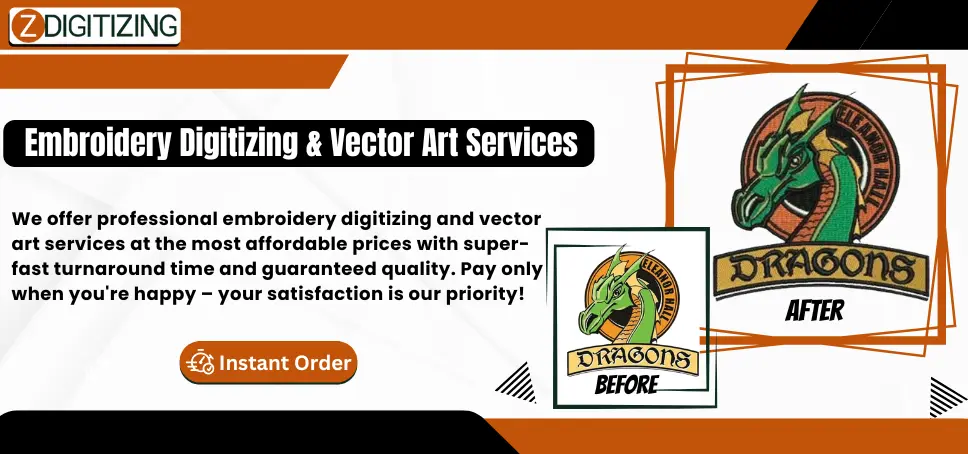A vector file format is the backbone of modern digital design, printing, and branding, yet many people don’t fully understand its power. Unlike regular image files, vectors can be scaled to any size without losing sharpness, making them the go-to choice for logos, signs, and professional artwork.
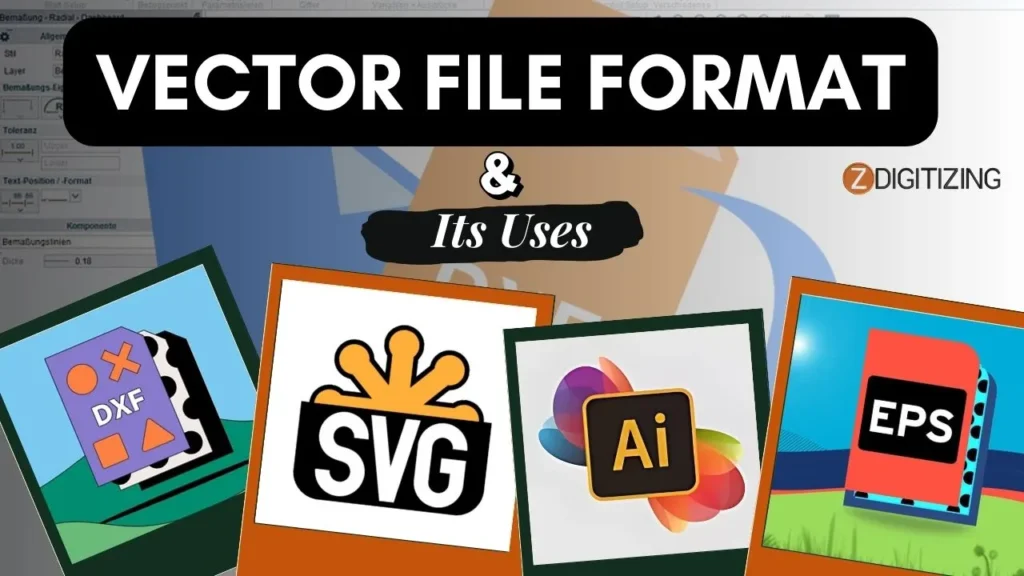
In this guide, we’ll break down exactly what vector files are, why they matter, and how you can use them effectively in everyday projects. Keep reading, by the end, you’ll know the secrets behind vectors that top designers and businesses rely on worldwide.
What is a Vector File Format and How to Use It Effectively?
What is a Vector File Format?
It is a type of digital image file that stores artwork using mathematical paths instead of tiny pixels. This means the design can be resized infinitely without losing quality or becoming blurry.
When we define vector file, it simply refers to an image built with lines, shapes, and curves that remain sharp at any scale. Unlike raster files, which are made of dots, vector graphics stay crisp whether you print them on a business card or a billboard.
In simple terms, the vector file meaning is clear: it’s a flexible, professional format used for logos, illustrations, technical drawings, and anything that needs perfect clarity in every size.
Anatomy of a Vector Graphics
Before you start using a vector file, it’s important to understand its anatomy. This will help you see how it really works and why it’s different from pixel-based images.
Vector art is made of these parts, and together they form a flexible vector image format that stays sharp at any size.
- Paths – The connected lines that shape the artwork.
- Anchor Points – Small dots that control the direction and position of paths.
- Curves & Lines – Smooth or straight edges that build the structure of the design.
- Fills & Strokes – The colors inside (fill) and outlines outside (stroke).
- Layers & Groups – A way to keep complex designs neat and easy to edit.
What are the Types of Vector File Formats?
Before you start working with vectors, it’s good to know that they don’t come in just one style. There are different vector graphics formats, and each one is built for a slightly different use.
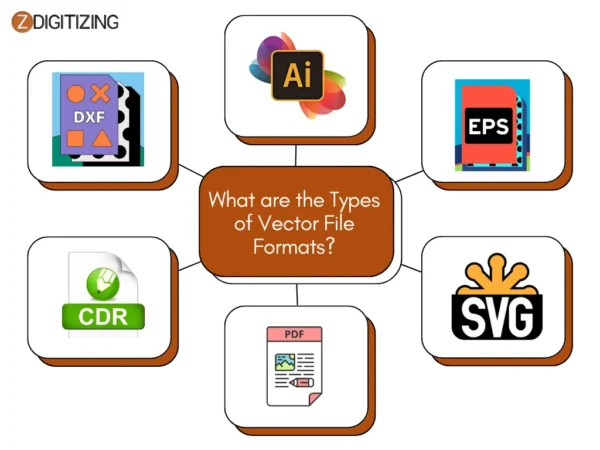
Here are the most common types you’ll come across:
- AI (Adobe Illustrator)
- EPS (Encapsulated PostScript)
- SVG (Scalable Vector Graphics)
- PDF (Portable Document Format – vector-based)
- CDR (CorelDRAW)
- DXF (Drawing Exchange Format for CAD)
1. AI (Adobe Illustrator)
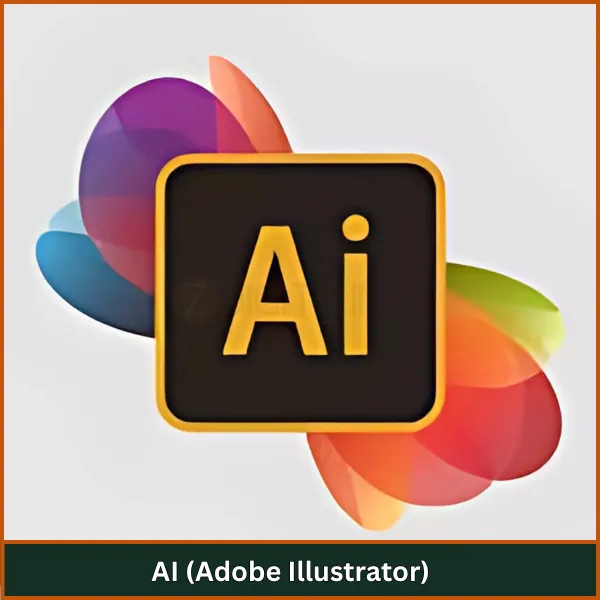
AI is one of the most popular vector file formats and the native format of Adobe Illustrator. It stores artwork as paths, which means you can resize designs infinitely without losing sharpness.
Designers prefer AI because it keeps layers, effects, and colors editable, making it perfect for branding, illustrations, and packaging.
These files are mainly edited in Adobe Illustrator, but the vector file extension can also be previewed in other apps when saved with PDF compatibility.
The main benefit is full flexibility, though advanced features don’t always transfer well outside Adobe software.
2. EPS (Encapsulated PostScript)
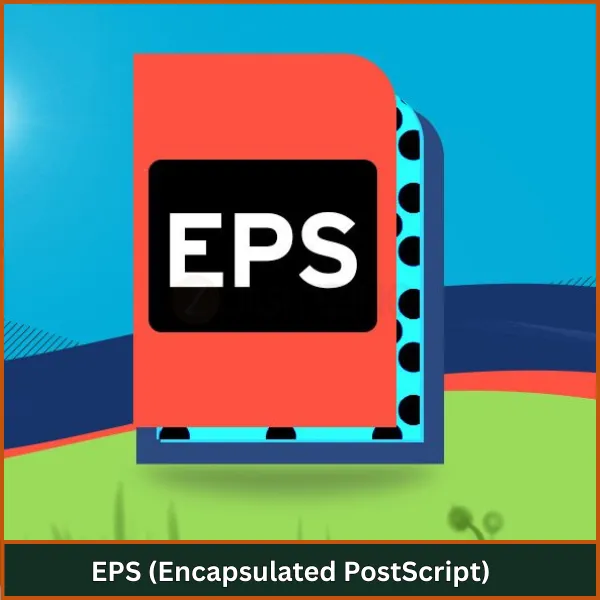
EPS is an older but very reliable choice among vector file types, especially in the printing industry. It can store both vector data and sometimes bitmap images, but it doesn’t support modern effects like transparency.
Printers still use EPS a lot because of its universal compatibility across different programs.
It’s a safe option for sharing logos and illustrations, though less versatile than AI or SVG.
3. SVG (Scalable Vector Graphics)
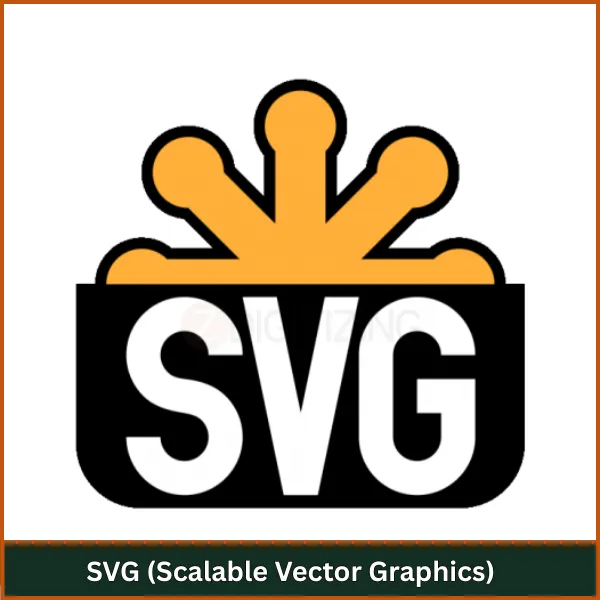
SVG is a web-friendly extension that works great for online graphics. It’s based on XML code, which makes it lightweight, easy to scale, and even animatable with CSS or JavaScript. Because of this, SVGs are widely used for website icons, digital logos, and interactive designs. They can be created in Illustrator, CorelDRAW, or free tools like Inkscape.
The main advantage is that they’re open standards and super flexible for the web, but they aren’t always the best fit for complex print projects.
4. PDF (Portable Document Format – Vector Based)
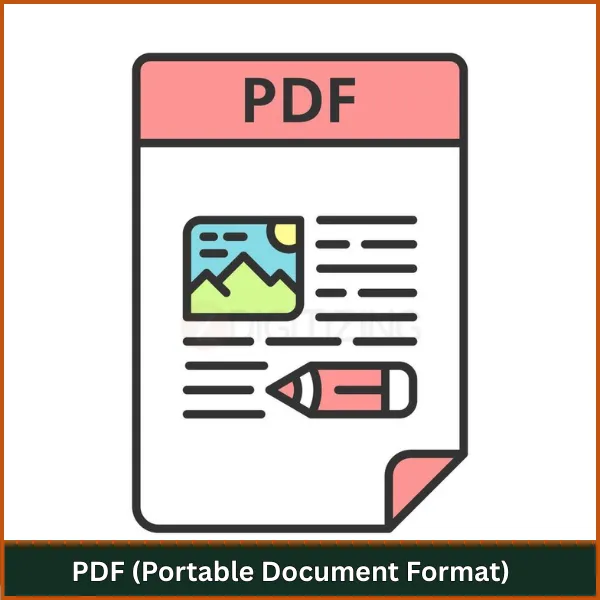
PDFs are extremely common because they can hold both raster images and vectors. When saved as a vector file format, a PDF keeps artwork sharp at any size and works perfectly for sharing across devices.
It’s widely used in print production and professional workflows since nearly every computer can open it. The strength of PDFs is their universality, but you must make sure the file is actually vector-based; otherwise, it could behave like a raster file.
5. CDR (CorelDRAW)
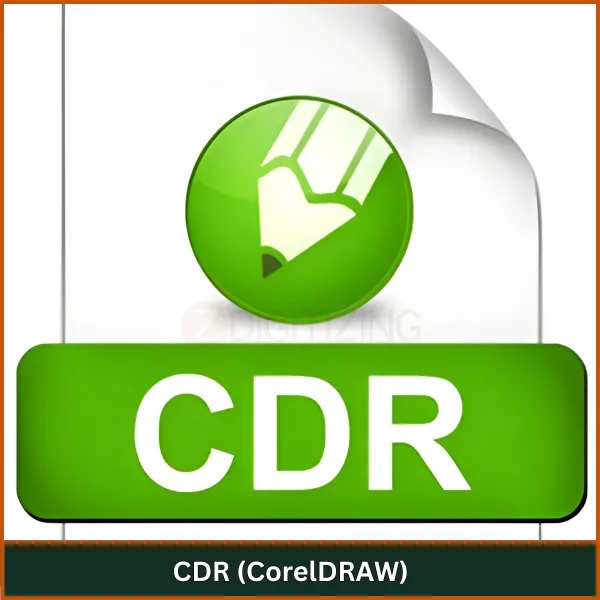
CDR is the native vector file extension for CorelDRAW. It supports gradients, transparency, and multiple pages, making it ideal for industries like signage and fashion design.
While CDR works great inside CorelDRAW, it’s not as widely compatible as AI or SVG files. To use it elsewhere, conversion is often required.
Its main benefit is that it keeps all Corel features intact, but the drawback is limited cross-software support.
6. DXF (Drawing Exchange Format for CAD)
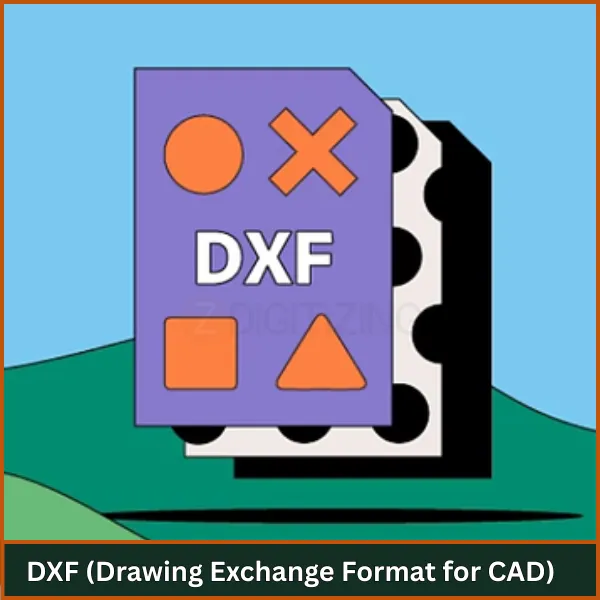
DXF is a specialized format created for CAD applications. Unlike artistic vector file types, it’s designed for technical precision in architecture, engineering, and manufacturing.
DXF files are perfect for CNC machines, 3D modeling, and laser cutting because they store accurate geometric details. They’re supported by AutoCAD and many CAD/CAM tools, but rarely used in creative design.
The strength of DXF is its accuracy, while its drawback is limited artistic use.
What are the Advantages of Vector File Formats?
- Vector files can be scaled to any size without losing quality, so they always stay sharp from small icons to large billboards.
- They usually take up less storage space compared to high-resolution raster images, making them easy to save and share.
- Editing is simple because you can change colors, shapes, or text without disturbing the whole design.
- They are ideal for logos and branding since graphics remain consistent across print, digital, and merchandise.
- Vectors are versatile and used in many industries like printing, embroidery, signage, web, and CAD.
- Their precision ensures clean, smooth lines and professional-looking artwork.
- Different vector formats, such as AI, EPS, SVG, and PDF, give flexibility to choose the right option for every project.
How to Open and Edit Vector Files?
Opening and editing vector file formats is easier than most people think. The main thing is choosing the right software and knowing how to use it.
Here’s a simple process you can follow:
- Choose the right software – If you’re a professional, Adobe Illustrator, CorelDRAW, or Affinity Designer are the best picks. For free options, Inkscape and Gravit Designer work well. Even browser-based editors can handle simple edits.
- Open the file – Launch your chosen program and go to File > Open. Select the correct vector file extension (like .ai, .eps, .svg, .cdr, or .pdf). Most software will recognize these formats instantly.
- Edit the design – Once opened, you can start editing. For example:
- Change the colors of shapes and text
- Resize objects without losing quality
- Adjust paths and anchor points to tweak shapes
- Add or remove layers for better organization
- Save or export the file – After editing, save it in the original format if you need to keep full editability. If you want to share it, export it as a different vector file type (like SVG for web, PDF for printing, or EPS for compatibility).
How to Use Vector File Format Effectively?
Using a vector graphic format the right way can save you time, improve quality, and keep your designs professional. Many beginners only see it as “just another image file,” but when used effectively, it becomes a powerful tool.
Here are some smart ways to get the most out of it:
- Always keep a master file – Save your original vector file so you can make changes anytime without losing quality.
- Export in the right format – Use PDF for print, SVG for websites, EPS for sharing with printers, and AI/CDR for editing.
- Organize with layers – Keep text, shapes, and backgrounds on separate layers for easy editing later.
- Use simple paths – Avoid overly complex paths that make files heavy and harder to edit.
- Check compatibility – If you’re sharing your design, make sure the other person’s software supports the types of vector files you’re sending.
- Plan for scalability – Think about where your design will be used (business cards, websites, billboards) and make sure it scales properly.
- Keep file names clear – Add the extension in the name so you can instantly recognize the right format.
When you follow these steps, vector files become more than just images; they turn into reusable assets that grow with your brand or business.
Conclusion: Why Vector File Formats Matter for You?
So, if you are wondering what is vector format, it’s the secret behind clean, sharp, and professional designs. No matter if it’s a small logo or a huge billboard, vectors keep the quality perfect. That’s why every business and brand needs them.
But we also know that working with vector files can feel difficult. Many people don’t have the time to learn software or struggle to get the results they want. This is where ZDigitizing makes your life easier.
At ZDigitizing, we create vector art by manually tracing every design, no shortcuts, no cheap auto-tracing. This means your artwork is guaranteed to be accurate, clean, and high-quality. We do this while keeping our prices affordable, so you get the best value for your money. On top of that, our 24/7 support team is always ready to help you, and we proudly deliver all types of vector art services worldwide.
So let us handle your designs with care and precision. We promise quality, speed, and affordability, all in one place. Contact us today and get 50% off on your first order. With ZDigitizing, your designs will always look perfect, everywhere.
FAQs
No, PNG is not a vector file. It’s a raster format made of pixels, which means it can lose quality when resized. PNG is best for web images and photos, not scalable designs.
A PDF can be both vector and raster, depending on how it’s saved. If created from vector software like Illustrator, it keeps vector data and stays sharp at any size.
You can make a vector file by using design software like Adobe Illustrator, CorelDRAW, or free tools like Inkscape. Another option is to convert a raster image into a vector using manual tracing for the best results.
Yes, SVG is a true vector file format. It’s mostly used for websites, icons, and digital graphics because it scales perfectly and loads fast online.
SVG is better for graphics, logos, and icons because it’s a scalable vector format. PNG works well for photos or web images but cannot be resized without losing quality.

